ACC5AAS - Analysis of Audit Risks & Internal Control at AMP Limited
VerifiedAdded on 2023/06/08
|12
|3450
|494
Report
AI Summary
This report provides an analysis of AMP Limited, focusing on its audit risks and internal control deficiencies. It begins with an introduction to AMP's core operations and highlights four key pieces of legislation impacting the company. The report then identifies four business risks affecting the audit and pinpoints specific accounts prone to material misstatements. Internal control weaknesses, as highlighted by the Royal Commission, are discussed. The report concludes with a recommendation regarding whether to undertake the audit, considering the prevalent risks and issues within the company. Desklib is a platform where students can find similar solved assignments and past papers.

qwertyuiopasdfghjklzxcvbnmqwertyui
opasdfghjklzxcvbnmqwertyuiopasdfgh
jklzxcvbnmqwertyuiopasdfghjklzxcvb
nmqwertyuiopasdfghjklzxcvbnmqwer
tyuiopasdfghjklzxcvbnmqwertyuiopas
dfghjklzxcvbnmqwertyuiopasdfghjklzx
cvbnmqwertyuiopasdfghjklzxcvbnmq
wertyuiopasdfghjklzxcvbnmqwertyuio
pasdfghjklzxcvbnmqwertyuiopasdfghj
klzxcvbnmqwertyuiopasdfghjklzxcvbn
mqwertyuiopasdfghjklzxcvbnmqwerty
uiopasdfghjklzxcvbnmqwertyuiopasdf
ghjklzxcvbnmqwertyuiopasdfghjklzxc
vbnmqwertyuiopasdfghjklzxcvbnmrty
uiopasdfghjklzxcvbnmqwertyuiopasdf
ghjklzxcvbnmqwertyuiopasdfghjklzxc
vbnmqwertyuiopasdfghjklzxcvbnmqw
Auditing and assurance
opasdfghjklzxcvbnmqwertyuiopasdfgh
jklzxcvbnmqwertyuiopasdfghjklzxcvb
nmqwertyuiopasdfghjklzxcvbnmqwer
tyuiopasdfghjklzxcvbnmqwertyuiopas
dfghjklzxcvbnmqwertyuiopasdfghjklzx
cvbnmqwertyuiopasdfghjklzxcvbnmq
wertyuiopasdfghjklzxcvbnmqwertyuio
pasdfghjklzxcvbnmqwertyuiopasdfghj
klzxcvbnmqwertyuiopasdfghjklzxcvbn
mqwertyuiopasdfghjklzxcvbnmqwerty
uiopasdfghjklzxcvbnmqwertyuiopasdf
ghjklzxcvbnmqwertyuiopasdfghjklzxc
vbnmqwertyuiopasdfghjklzxcvbnmrty
uiopasdfghjklzxcvbnmqwertyuiopasdf
ghjklzxcvbnmqwertyuiopasdfghjklzxc
vbnmqwertyuiopasdfghjklzxcvbnmqw
Auditing and assurance
Paraphrase This Document
Need a fresh take? Get an instant paraphrase of this document with our AI Paraphraser
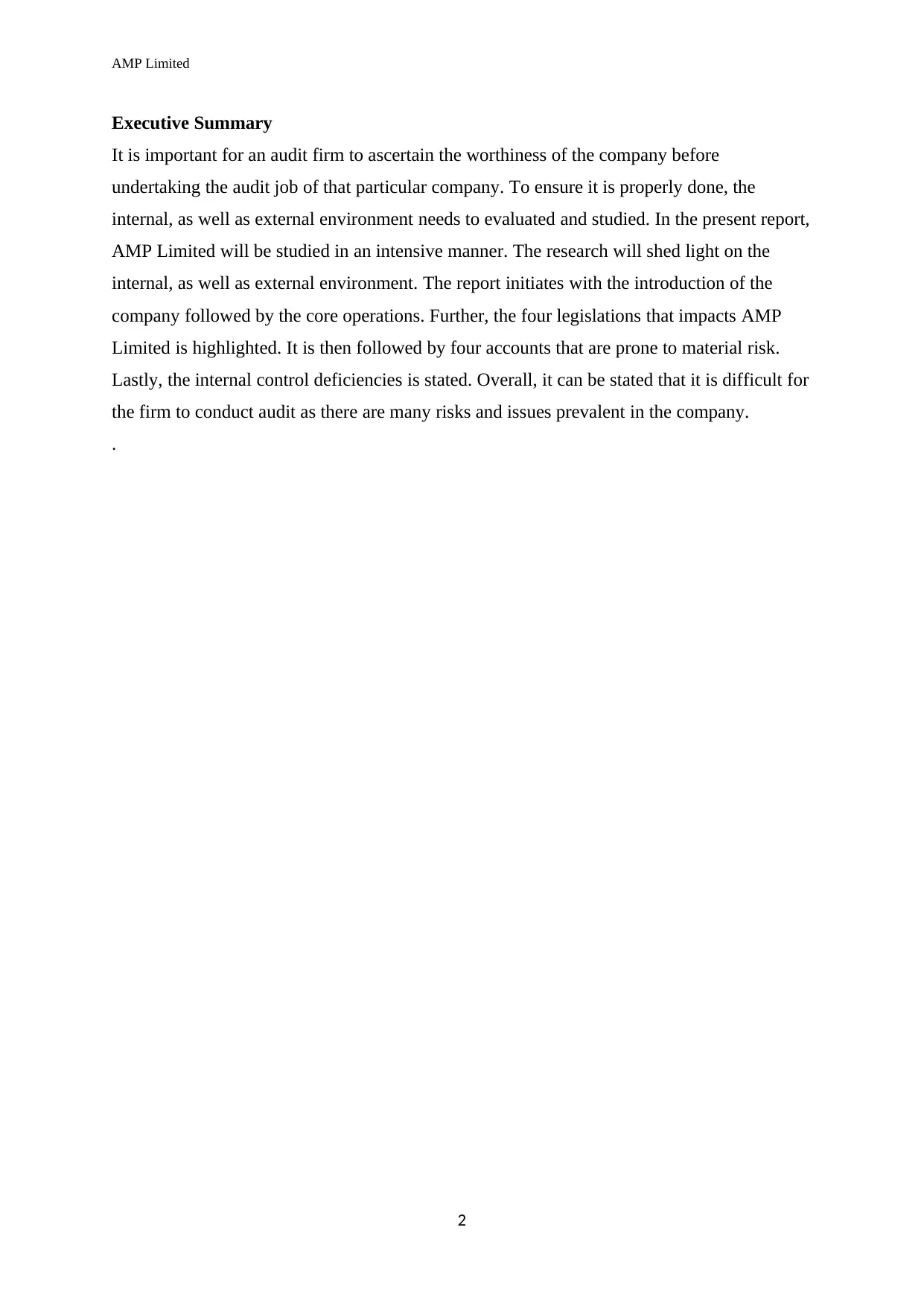
AMP Limited
Executive Summary
It is important for an audit firm to ascertain the worthiness of the company before
undertaking the audit job of that particular company. To ensure it is properly done, the
internal, as well as external environment needs to evaluated and studied. In the present report,
AMP Limited will be studied in an intensive manner. The research will shed light on the
internal, as well as external environment. The report initiates with the introduction of the
company followed by the core operations. Further, the four legislations that impacts AMP
Limited is highlighted. It is then followed by four accounts that are prone to material risk.
Lastly, the internal control deficiencies is stated. Overall, it can be stated that it is difficult for
the firm to conduct audit as there are many risks and issues prevalent in the company.
.
2
Executive Summary
It is important for an audit firm to ascertain the worthiness of the company before
undertaking the audit job of that particular company. To ensure it is properly done, the
internal, as well as external environment needs to evaluated and studied. In the present report,
AMP Limited will be studied in an intensive manner. The research will shed light on the
internal, as well as external environment. The report initiates with the introduction of the
company followed by the core operations. Further, the four legislations that impacts AMP
Limited is highlighted. It is then followed by four accounts that are prone to material risk.
Lastly, the internal control deficiencies is stated. Overall, it can be stated that it is difficult for
the firm to conduct audit as there are many risks and issues prevalent in the company.
.
2

AMP Limited
Contents
Introduction...........................................................................................................................................4
1. Areas in which AMP conducts its operations.................................................................................4
2. Four law/legislation that impacts AMP..........................................................................................5
3. FOUR business risks that affect the audit of AMP..........................................................................6
4. Four accounts to be at risk of material misstatements..................................................................8
5. Internal control weakness highlighted by Royal Commission........................................................9
6. Decision/ Conclusion for undertaking the audit..........................................................................10
References...........................................................................................................................................11
3
Contents
Introduction...........................................................................................................................................4
1. Areas in which AMP conducts its operations.................................................................................4
2. Four law/legislation that impacts AMP..........................................................................................5
3. FOUR business risks that affect the audit of AMP..........................................................................6
4. Four accounts to be at risk of material misstatements..................................................................8
5. Internal control weakness highlighted by Royal Commission........................................................9
6. Decision/ Conclusion for undertaking the audit..........................................................................10
References...........................................................................................................................................11
3
⊘ This is a preview!⊘
Do you want full access?
Subscribe today to unlock all pages.

Trusted by 1+ million students worldwide
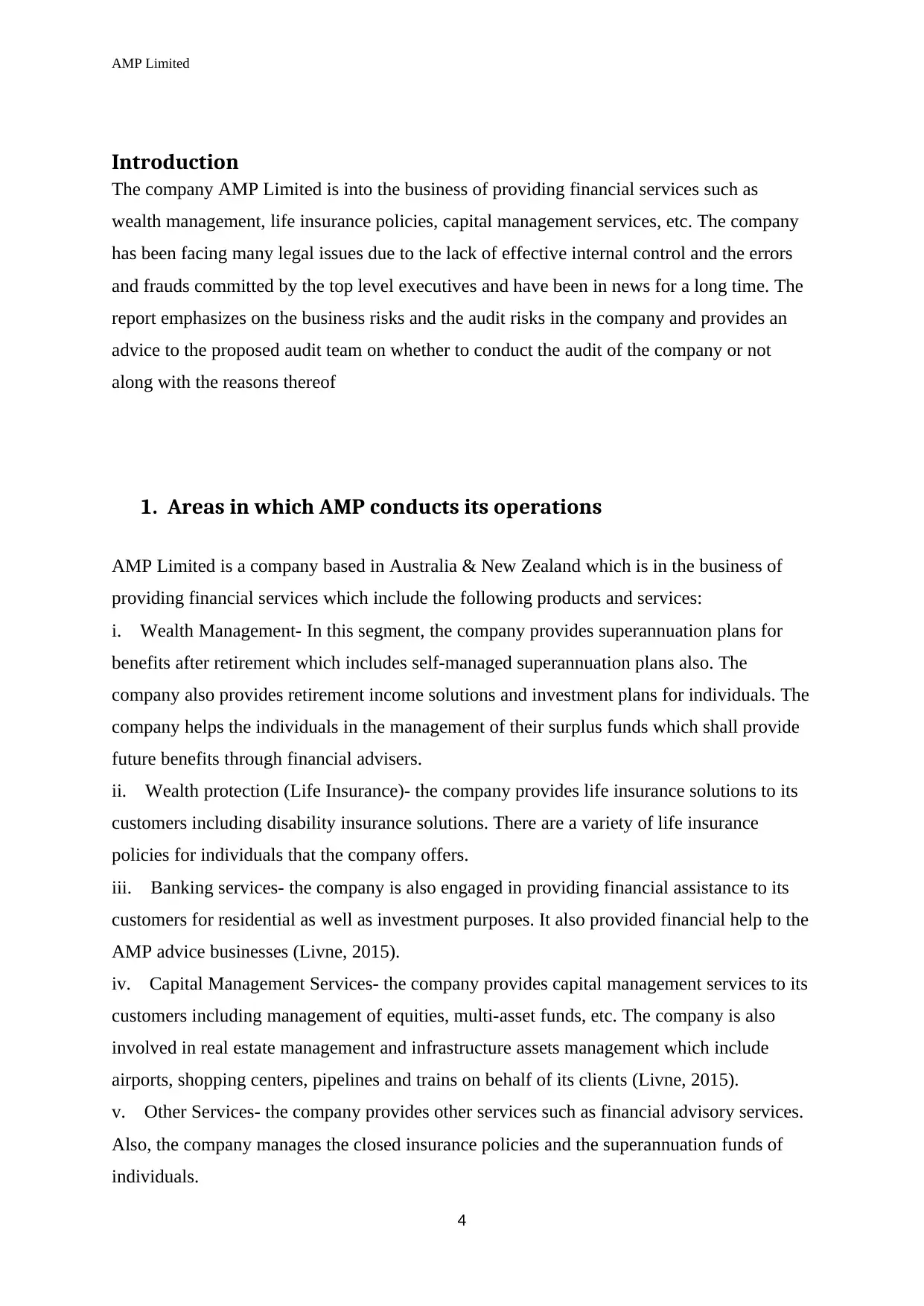
AMP Limited
Introduction
The company AMP Limited is into the business of providing financial services such as
wealth management, life insurance policies, capital management services, etc. The company
has been facing many legal issues due to the lack of effective internal control and the errors
and frauds committed by the top level executives and have been in news for a long time. The
report emphasizes on the business risks and the audit risks in the company and provides an
advice to the proposed audit team on whether to conduct the audit of the company or not
along with the reasons thereof
1. Areas in which AMP conducts its operations
AMP Limited is a company based in Australia & New Zealand which is in the business of
providing financial services which include the following products and services:
i. Wealth Management- In this segment, the company provides superannuation plans for
benefits after retirement which includes self-managed superannuation plans also. The
company also provides retirement income solutions and investment plans for individuals. The
company helps the individuals in the management of their surplus funds which shall provide
future benefits through financial advisers.
ii. Wealth protection (Life Insurance)- the company provides life insurance solutions to its
customers including disability insurance solutions. There are a variety of life insurance
policies for individuals that the company offers.
iii. Banking services- the company is also engaged in providing financial assistance to its
customers for residential as well as investment purposes. It also provided financial help to the
AMP advice businesses (Livne, 2015).
iv. Capital Management Services- the company provides capital management services to its
customers including management of equities, multi-asset funds, etc. The company is also
involved in real estate management and infrastructure assets management which include
airports, shopping centers, pipelines and trains on behalf of its clients (Livne, 2015).
v. Other Services- the company provides other services such as financial advisory services.
Also, the company manages the closed insurance policies and the superannuation funds of
individuals.
4
Introduction
The company AMP Limited is into the business of providing financial services such as
wealth management, life insurance policies, capital management services, etc. The company
has been facing many legal issues due to the lack of effective internal control and the errors
and frauds committed by the top level executives and have been in news for a long time. The
report emphasizes on the business risks and the audit risks in the company and provides an
advice to the proposed audit team on whether to conduct the audit of the company or not
along with the reasons thereof
1. Areas in which AMP conducts its operations
AMP Limited is a company based in Australia & New Zealand which is in the business of
providing financial services which include the following products and services:
i. Wealth Management- In this segment, the company provides superannuation plans for
benefits after retirement which includes self-managed superannuation plans also. The
company also provides retirement income solutions and investment plans for individuals. The
company helps the individuals in the management of their surplus funds which shall provide
future benefits through financial advisers.
ii. Wealth protection (Life Insurance)- the company provides life insurance solutions to its
customers including disability insurance solutions. There are a variety of life insurance
policies for individuals that the company offers.
iii. Banking services- the company is also engaged in providing financial assistance to its
customers for residential as well as investment purposes. It also provided financial help to the
AMP advice businesses (Livne, 2015).
iv. Capital Management Services- the company provides capital management services to its
customers including management of equities, multi-asset funds, etc. The company is also
involved in real estate management and infrastructure assets management which include
airports, shopping centers, pipelines and trains on behalf of its clients (Livne, 2015).
v. Other Services- the company provides other services such as financial advisory services.
Also, the company manages the closed insurance policies and the superannuation funds of
individuals.
4
Paraphrase This Document
Need a fresh take? Get an instant paraphrase of this document with our AI Paraphraser
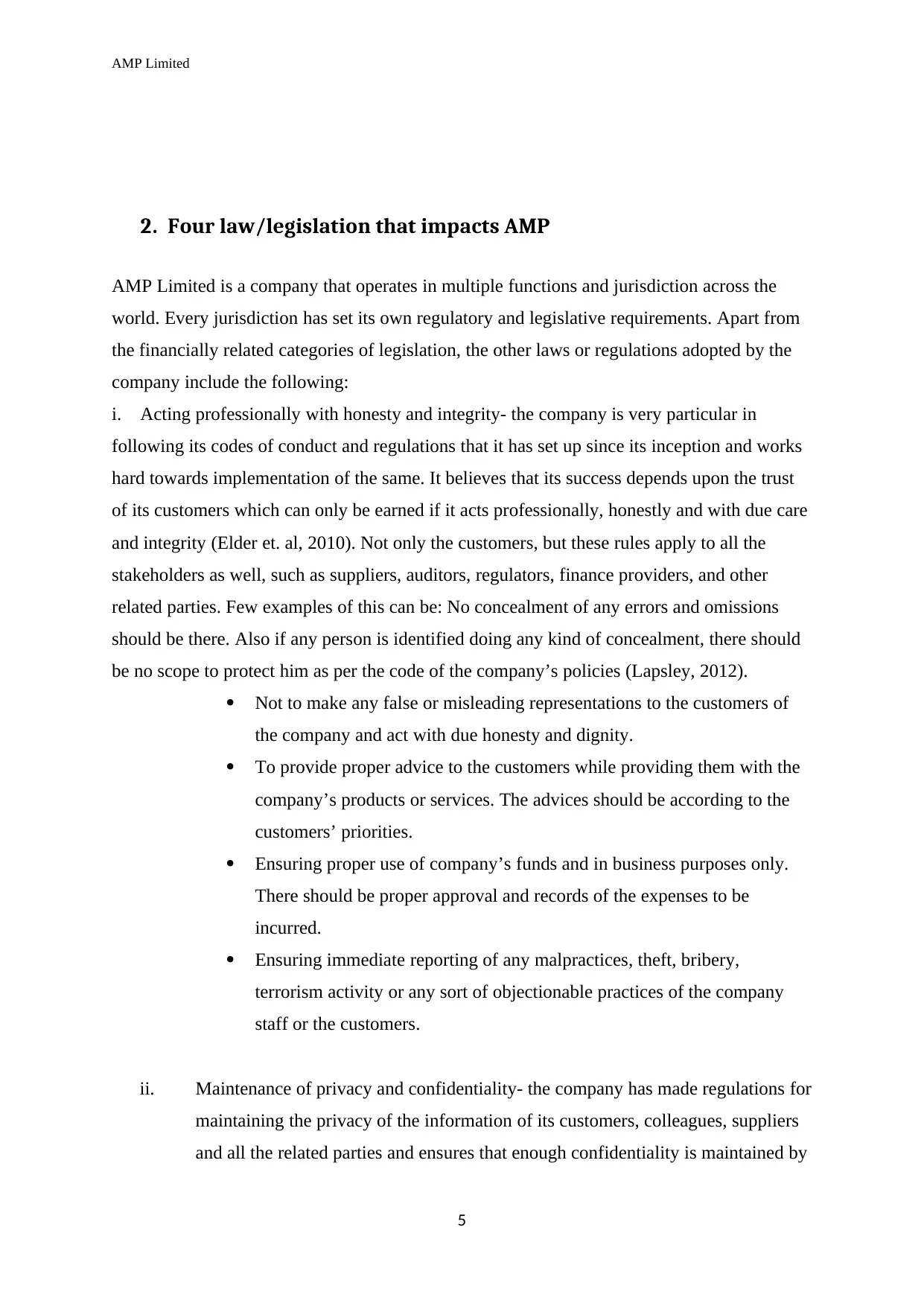
AMP Limited
2. Four law/legislation that impacts AMP
AMP Limited is a company that operates in multiple functions and jurisdiction across the
world. Every jurisdiction has set its own regulatory and legislative requirements. Apart from
the financially related categories of legislation, the other laws or regulations adopted by the
company include the following:
i. Acting professionally with honesty and integrity- the company is very particular in
following its codes of conduct and regulations that it has set up since its inception and works
hard towards implementation of the same. It believes that its success depends upon the trust
of its customers which can only be earned if it acts professionally, honestly and with due care
and integrity (Elder et. al, 2010). Not only the customers, but these rules apply to all the
stakeholders as well, such as suppliers, auditors, regulators, finance providers, and other
related parties. Few examples of this can be: No concealment of any errors and omissions
should be there. Also if any person is identified doing any kind of concealment, there should
be no scope to protect him as per the code of the company’s policies (Lapsley, 2012).
Not to make any false or misleading representations to the customers of
the company and act with due honesty and dignity.
To provide proper advice to the customers while providing them with the
company’s products or services. The advices should be according to the
customers’ priorities.
Ensuring proper use of company’s funds and in business purposes only.
There should be proper approval and records of the expenses to be
incurred.
Ensuring immediate reporting of any malpractices, theft, bribery,
terrorism activity or any sort of objectionable practices of the company
staff or the customers.
ii. Maintenance of privacy and confidentiality- the company has made regulations for
maintaining the privacy of the information of its customers, colleagues, suppliers
and all the related parties and ensures that enough confidentiality is maintained by
5
2. Four law/legislation that impacts AMP
AMP Limited is a company that operates in multiple functions and jurisdiction across the
world. Every jurisdiction has set its own regulatory and legislative requirements. Apart from
the financially related categories of legislation, the other laws or regulations adopted by the
company include the following:
i. Acting professionally with honesty and integrity- the company is very particular in
following its codes of conduct and regulations that it has set up since its inception and works
hard towards implementation of the same. It believes that its success depends upon the trust
of its customers which can only be earned if it acts professionally, honestly and with due care
and integrity (Elder et. al, 2010). Not only the customers, but these rules apply to all the
stakeholders as well, such as suppliers, auditors, regulators, finance providers, and other
related parties. Few examples of this can be: No concealment of any errors and omissions
should be there. Also if any person is identified doing any kind of concealment, there should
be no scope to protect him as per the code of the company’s policies (Lapsley, 2012).
Not to make any false or misleading representations to the customers of
the company and act with due honesty and dignity.
To provide proper advice to the customers while providing them with the
company’s products or services. The advices should be according to the
customers’ priorities.
Ensuring proper use of company’s funds and in business purposes only.
There should be proper approval and records of the expenses to be
incurred.
Ensuring immediate reporting of any malpractices, theft, bribery,
terrorism activity or any sort of objectionable practices of the company
staff or the customers.
ii. Maintenance of privacy and confidentiality- the company has made regulations for
maintaining the privacy of the information of its customers, colleagues, suppliers
and all the related parties and ensures that enough confidentiality is maintained by
5
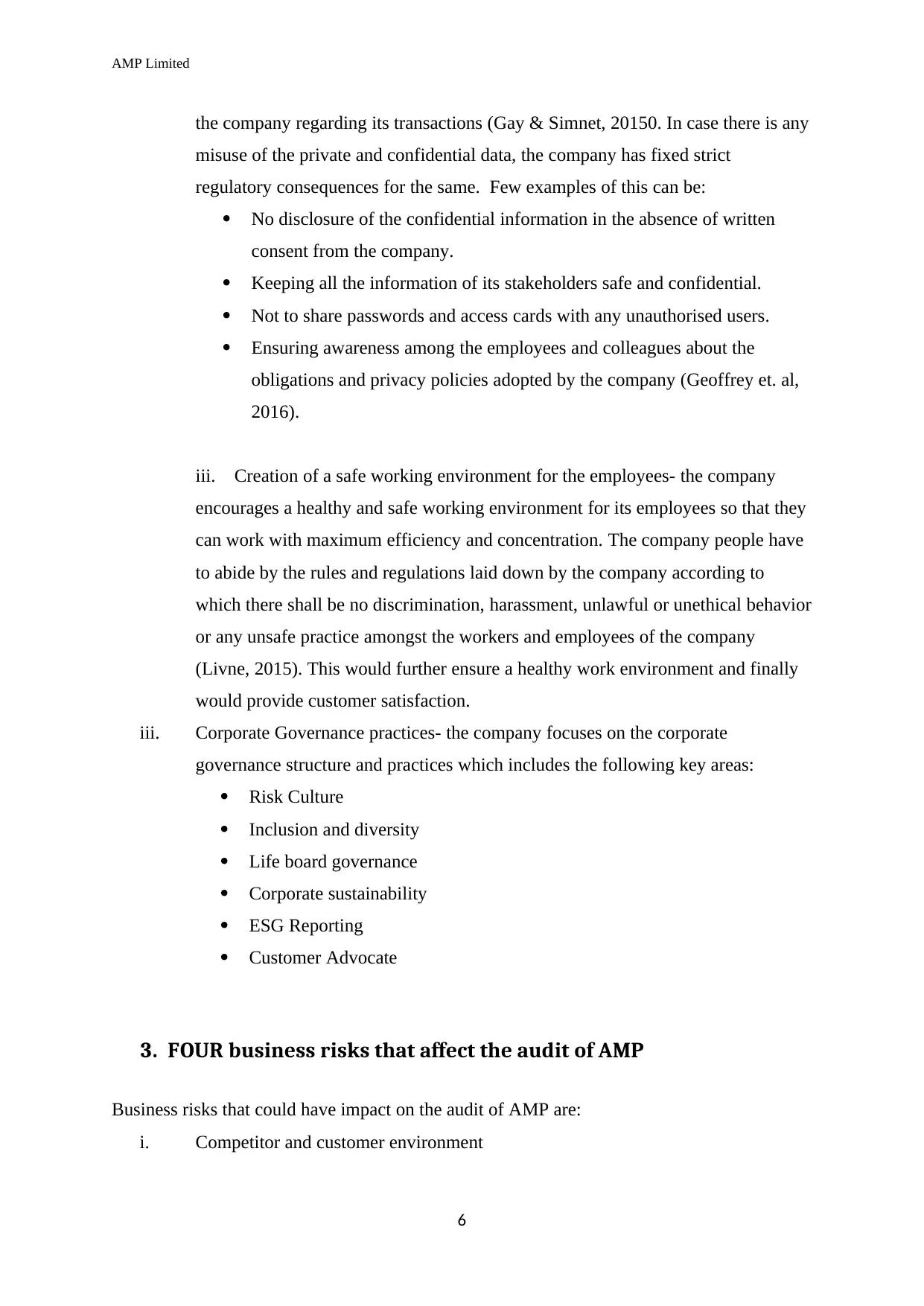
AMP Limited
the company regarding its transactions (Gay & Simnet, 20150. In case there is any
misuse of the private and confidential data, the company has fixed strict
regulatory consequences for the same. Few examples of this can be:
No disclosure of the confidential information in the absence of written
consent from the company.
Keeping all the information of its stakeholders safe and confidential.
Not to share passwords and access cards with any unauthorised users.
Ensuring awareness among the employees and colleagues about the
obligations and privacy policies adopted by the company (Geoffrey et. al,
2016).
iii. Creation of a safe working environment for the employees- the company
encourages a healthy and safe working environment for its employees so that they
can work with maximum efficiency and concentration. The company people have
to abide by the rules and regulations laid down by the company according to
which there shall be no discrimination, harassment, unlawful or unethical behavior
or any unsafe practice amongst the workers and employees of the company
(Livne, 2015). This would further ensure a healthy work environment and finally
would provide customer satisfaction.
iii. Corporate Governance practices- the company focuses on the corporate
governance structure and practices which includes the following key areas:
Risk Culture
Inclusion and diversity
Life board governance
Corporate sustainability
ESG Reporting
Customer Advocate
3. FOUR business risks that affect the audit of AMP
Business risks that could have impact on the audit of AMP are:
i. Competitor and customer environment
6
the company regarding its transactions (Gay & Simnet, 20150. In case there is any
misuse of the private and confidential data, the company has fixed strict
regulatory consequences for the same. Few examples of this can be:
No disclosure of the confidential information in the absence of written
consent from the company.
Keeping all the information of its stakeholders safe and confidential.
Not to share passwords and access cards with any unauthorised users.
Ensuring awareness among the employees and colleagues about the
obligations and privacy policies adopted by the company (Geoffrey et. al,
2016).
iii. Creation of a safe working environment for the employees- the company
encourages a healthy and safe working environment for its employees so that they
can work with maximum efficiency and concentration. The company people have
to abide by the rules and regulations laid down by the company according to
which there shall be no discrimination, harassment, unlawful or unethical behavior
or any unsafe practice amongst the workers and employees of the company
(Livne, 2015). This would further ensure a healthy work environment and finally
would provide customer satisfaction.
iii. Corporate Governance practices- the company focuses on the corporate
governance structure and practices which includes the following key areas:
Risk Culture
Inclusion and diversity
Life board governance
Corporate sustainability
ESG Reporting
Customer Advocate
3. FOUR business risks that affect the audit of AMP
Business risks that could have impact on the audit of AMP are:
i. Competitor and customer environment
6
⊘ This is a preview!⊘
Do you want full access?
Subscribe today to unlock all pages.

Trusted by 1+ million students worldwide
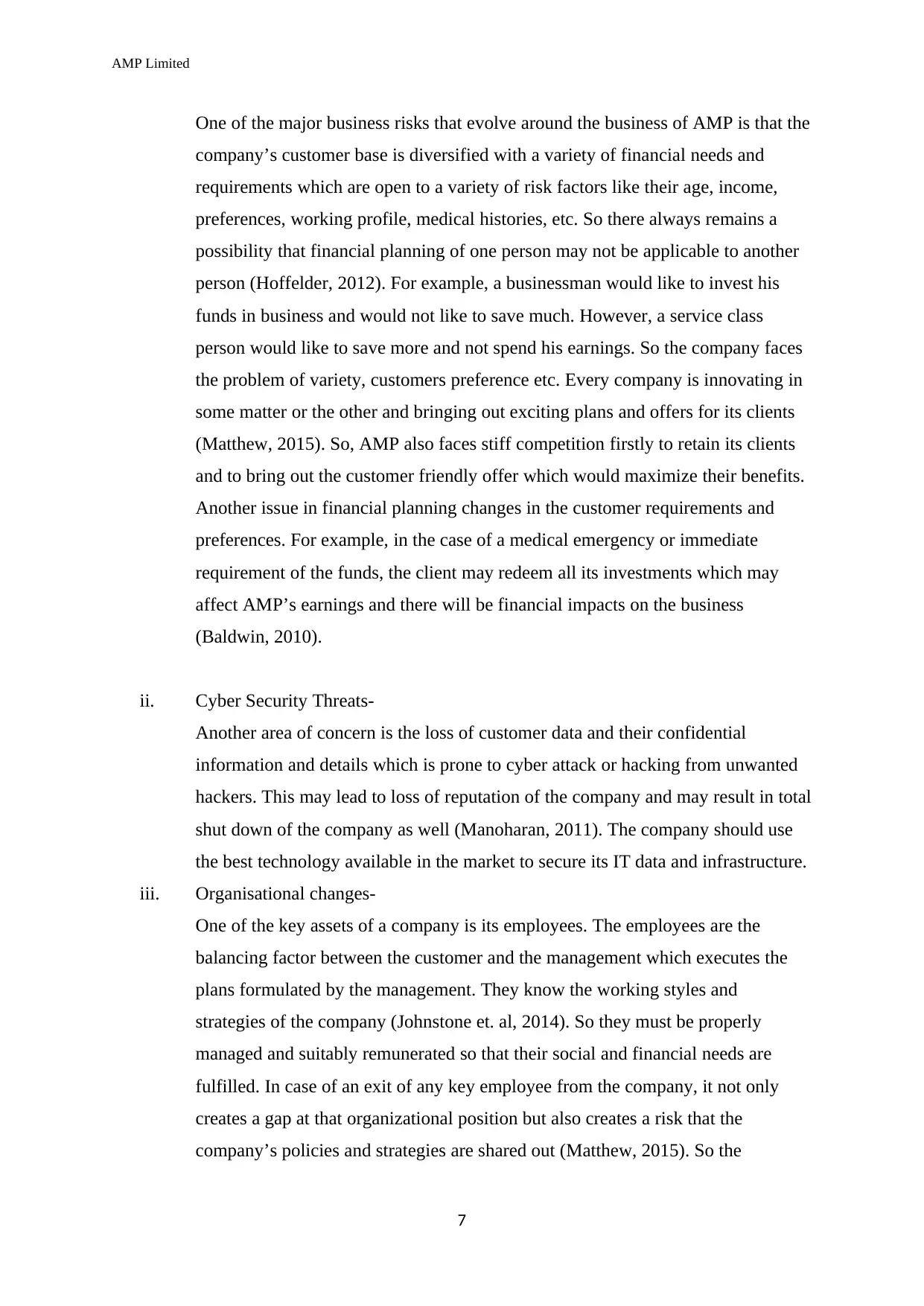
AMP Limited
One of the major business risks that evolve around the business of AMP is that the
company’s customer base is diversified with a variety of financial needs and
requirements which are open to a variety of risk factors like their age, income,
preferences, working profile, medical histories, etc. So there always remains a
possibility that financial planning of one person may not be applicable to another
person (Hoffelder, 2012). For example, a businessman would like to invest his
funds in business and would not like to save much. However, a service class
person would like to save more and not spend his earnings. So the company faces
the problem of variety, customers preference etc. Every company is innovating in
some matter or the other and bringing out exciting plans and offers for its clients
(Matthew, 2015). So, AMP also faces stiff competition firstly to retain its clients
and to bring out the customer friendly offer which would maximize their benefits.
Another issue in financial planning changes in the customer requirements and
preferences. For example, in the case of a medical emergency or immediate
requirement of the funds, the client may redeem all its investments which may
affect AMP’s earnings and there will be financial impacts on the business
(Baldwin, 2010).
ii. Cyber Security Threats-
Another area of concern is the loss of customer data and their confidential
information and details which is prone to cyber attack or hacking from unwanted
hackers. This may lead to loss of reputation of the company and may result in total
shut down of the company as well (Manoharan, 2011). The company should use
the best technology available in the market to secure its IT data and infrastructure.
iii. Organisational changes-
One of the key assets of a company is its employees. The employees are the
balancing factor between the customer and the management which executes the
plans formulated by the management. They know the working styles and
strategies of the company (Johnstone et. al, 2014). So they must be properly
managed and suitably remunerated so that their social and financial needs are
fulfilled. In case of an exit of any key employee from the company, it not only
creates a gap at that organizational position but also creates a risk that the
company’s policies and strategies are shared out (Matthew, 2015). So the
7
One of the major business risks that evolve around the business of AMP is that the
company’s customer base is diversified with a variety of financial needs and
requirements which are open to a variety of risk factors like their age, income,
preferences, working profile, medical histories, etc. So there always remains a
possibility that financial planning of one person may not be applicable to another
person (Hoffelder, 2012). For example, a businessman would like to invest his
funds in business and would not like to save much. However, a service class
person would like to save more and not spend his earnings. So the company faces
the problem of variety, customers preference etc. Every company is innovating in
some matter or the other and bringing out exciting plans and offers for its clients
(Matthew, 2015). So, AMP also faces stiff competition firstly to retain its clients
and to bring out the customer friendly offer which would maximize their benefits.
Another issue in financial planning changes in the customer requirements and
preferences. For example, in the case of a medical emergency or immediate
requirement of the funds, the client may redeem all its investments which may
affect AMP’s earnings and there will be financial impacts on the business
(Baldwin, 2010).
ii. Cyber Security Threats-
Another area of concern is the loss of customer data and their confidential
information and details which is prone to cyber attack or hacking from unwanted
hackers. This may lead to loss of reputation of the company and may result in total
shut down of the company as well (Manoharan, 2011). The company should use
the best technology available in the market to secure its IT data and infrastructure.
iii. Organisational changes-
One of the key assets of a company is its employees. The employees are the
balancing factor between the customer and the management which executes the
plans formulated by the management. They know the working styles and
strategies of the company (Johnstone et. al, 2014). So they must be properly
managed and suitably remunerated so that their social and financial needs are
fulfilled. In case of an exit of any key employee from the company, it not only
creates a gap at that organizational position but also creates a risk that the
company’s policies and strategies are shared out (Matthew, 2015). So the
7
Paraphrase This Document
Need a fresh take? Get an instant paraphrase of this document with our AI Paraphraser
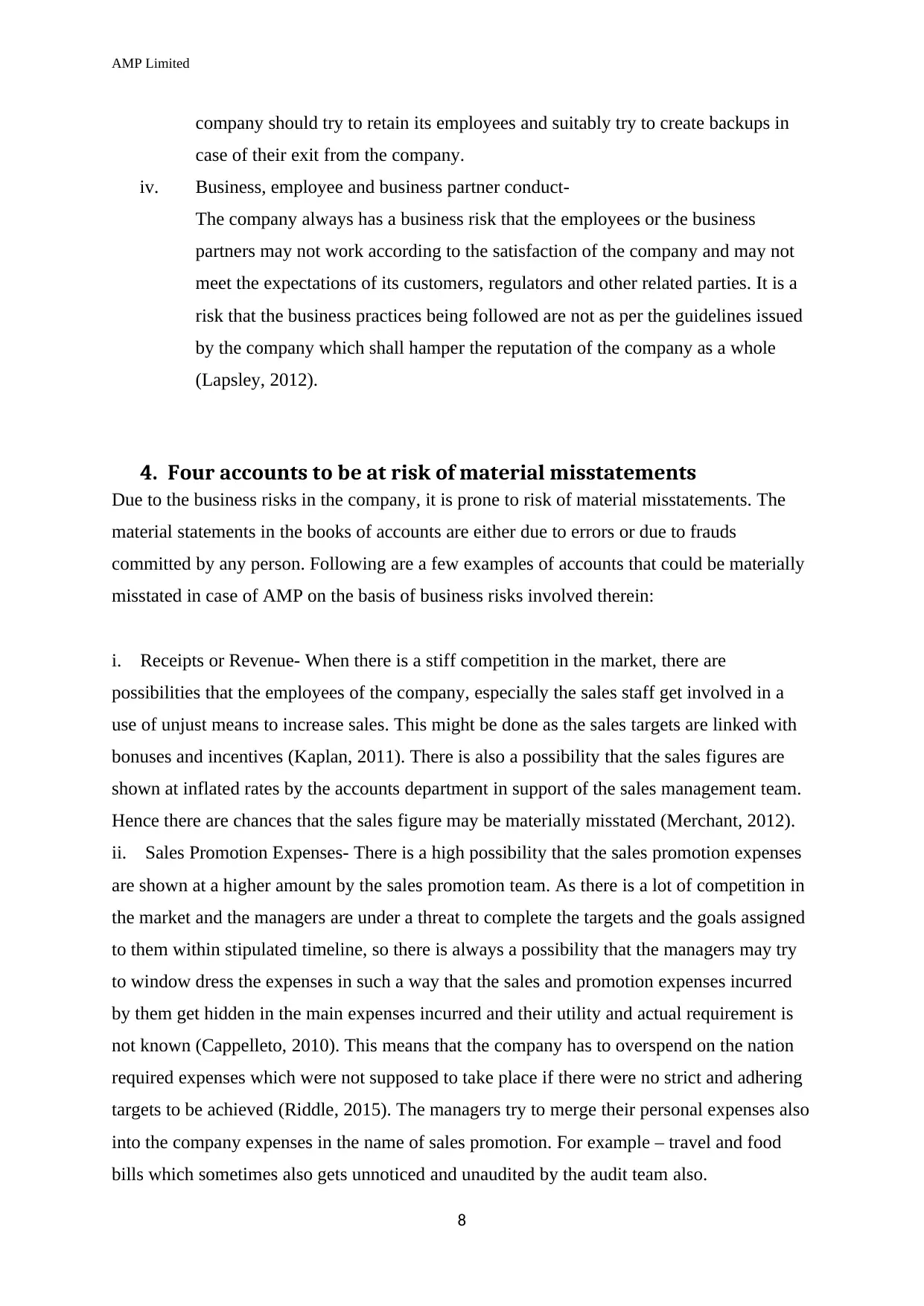
AMP Limited
company should try to retain its employees and suitably try to create backups in
case of their exit from the company.
iv. Business, employee and business partner conduct-
The company always has a business risk that the employees or the business
partners may not work according to the satisfaction of the company and may not
meet the expectations of its customers, regulators and other related parties. It is a
risk that the business practices being followed are not as per the guidelines issued
by the company which shall hamper the reputation of the company as a whole
(Lapsley, 2012).
4. Four accounts to be at risk of material misstatements
Due to the business risks in the company, it is prone to risk of material misstatements. The
material statements in the books of accounts are either due to errors or due to frauds
committed by any person. Following are a few examples of accounts that could be materially
misstated in case of AMP on the basis of business risks involved therein:
i. Receipts or Revenue- When there is a stiff competition in the market, there are
possibilities that the employees of the company, especially the sales staff get involved in a
use of unjust means to increase sales. This might be done as the sales targets are linked with
bonuses and incentives (Kaplan, 2011). There is also a possibility that the sales figures are
shown at inflated rates by the accounts department in support of the sales management team.
Hence there are chances that the sales figure may be materially misstated (Merchant, 2012).
ii. Sales Promotion Expenses- There is a high possibility that the sales promotion expenses
are shown at a higher amount by the sales promotion team. As there is a lot of competition in
the market and the managers are under a threat to complete the targets and the goals assigned
to them within stipulated timeline, so there is always a possibility that the managers may try
to window dress the expenses in such a way that the sales and promotion expenses incurred
by them get hidden in the main expenses incurred and their utility and actual requirement is
not known (Cappelleto, 2010). This means that the company has to overspend on the nation
required expenses which were not supposed to take place if there were no strict and adhering
targets to be achieved (Riddle, 2015). The managers try to merge their personal expenses also
into the company expenses in the name of sales promotion. For example – travel and food
bills which sometimes also gets unnoticed and unaudited by the audit team also.
8
company should try to retain its employees and suitably try to create backups in
case of their exit from the company.
iv. Business, employee and business partner conduct-
The company always has a business risk that the employees or the business
partners may not work according to the satisfaction of the company and may not
meet the expectations of its customers, regulators and other related parties. It is a
risk that the business practices being followed are not as per the guidelines issued
by the company which shall hamper the reputation of the company as a whole
(Lapsley, 2012).
4. Four accounts to be at risk of material misstatements
Due to the business risks in the company, it is prone to risk of material misstatements. The
material statements in the books of accounts are either due to errors or due to frauds
committed by any person. Following are a few examples of accounts that could be materially
misstated in case of AMP on the basis of business risks involved therein:
i. Receipts or Revenue- When there is a stiff competition in the market, there are
possibilities that the employees of the company, especially the sales staff get involved in a
use of unjust means to increase sales. This might be done as the sales targets are linked with
bonuses and incentives (Kaplan, 2011). There is also a possibility that the sales figures are
shown at inflated rates by the accounts department in support of the sales management team.
Hence there are chances that the sales figure may be materially misstated (Merchant, 2012).
ii. Sales Promotion Expenses- There is a high possibility that the sales promotion expenses
are shown at a higher amount by the sales promotion team. As there is a lot of competition in
the market and the managers are under a threat to complete the targets and the goals assigned
to them within stipulated timeline, so there is always a possibility that the managers may try
to window dress the expenses in such a way that the sales and promotion expenses incurred
by them get hidden in the main expenses incurred and their utility and actual requirement is
not known (Cappelleto, 2010). This means that the company has to overspend on the nation
required expenses which were not supposed to take place if there were no strict and adhering
targets to be achieved (Riddle, 2015). The managers try to merge their personal expenses also
into the company expenses in the name of sales promotion. For example – travel and food
bills which sometimes also gets unnoticed and unaudited by the audit team also.
8
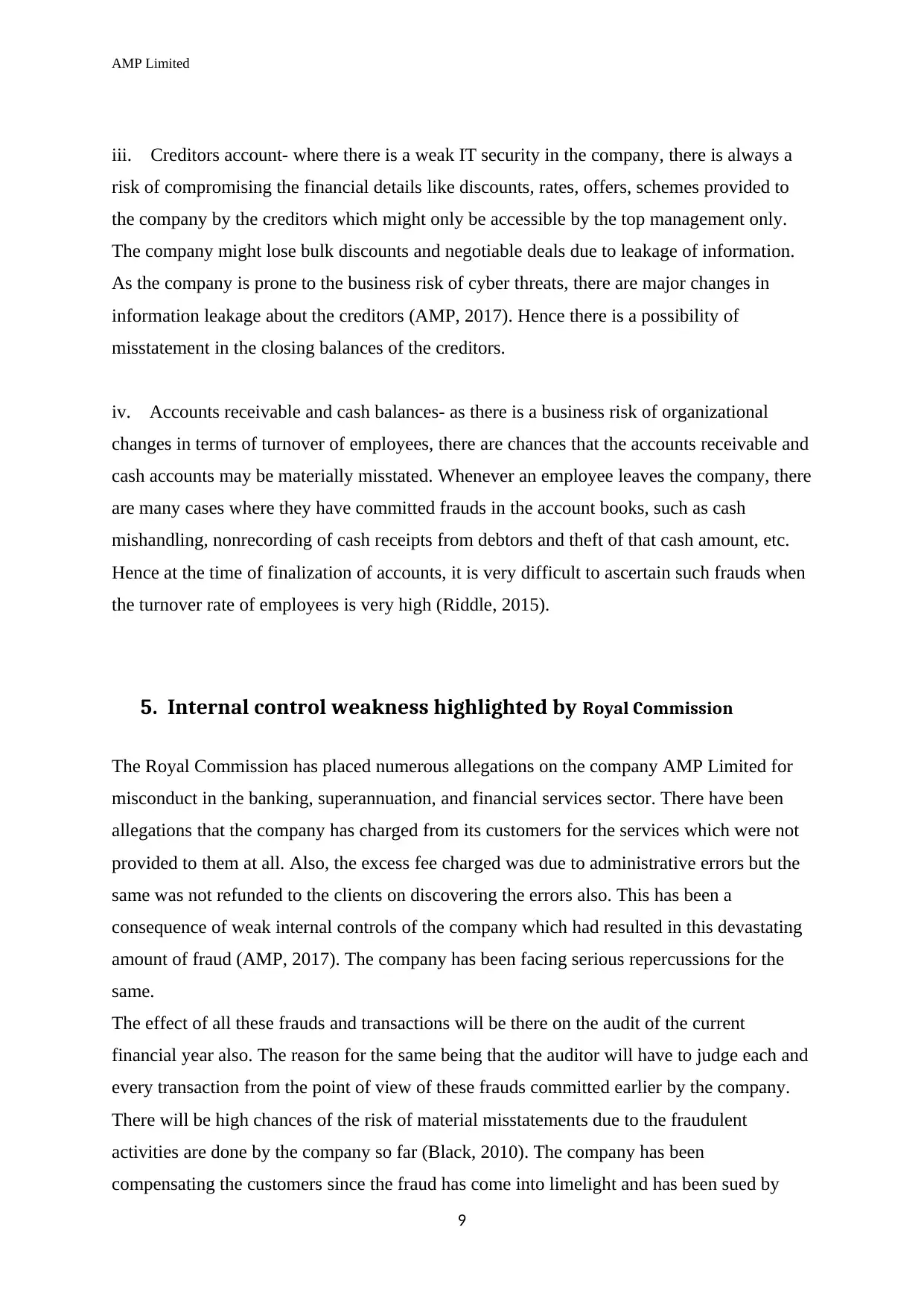
AMP Limited
iii. Creditors account- where there is a weak IT security in the company, there is always a
risk of compromising the financial details like discounts, rates, offers, schemes provided to
the company by the creditors which might only be accessible by the top management only.
The company might lose bulk discounts and negotiable deals due to leakage of information.
As the company is prone to the business risk of cyber threats, there are major changes in
information leakage about the creditors (AMP, 2017). Hence there is a possibility of
misstatement in the closing balances of the creditors.
iv. Accounts receivable and cash balances- as there is a business risk of organizational
changes in terms of turnover of employees, there are chances that the accounts receivable and
cash accounts may be materially misstated. Whenever an employee leaves the company, there
are many cases where they have committed frauds in the account books, such as cash
mishandling, nonrecording of cash receipts from debtors and theft of that cash amount, etc.
Hence at the time of finalization of accounts, it is very difficult to ascertain such frauds when
the turnover rate of employees is very high (Riddle, 2015).
5. Internal control weakness highlighted by Royal Commission
The Royal Commission has placed numerous allegations on the company AMP Limited for
misconduct in the banking, superannuation, and financial services sector. There have been
allegations that the company has charged from its customers for the services which were not
provided to them at all. Also, the excess fee charged was due to administrative errors but the
same was not refunded to the clients on discovering the errors also. This has been a
consequence of weak internal controls of the company which had resulted in this devastating
amount of fraud (AMP, 2017). The company has been facing serious repercussions for the
same.
The effect of all these frauds and transactions will be there on the audit of the current
financial year also. The reason for the same being that the auditor will have to judge each and
every transaction from the point of view of these frauds committed earlier by the company.
There will be high chances of the risk of material misstatements due to the fraudulent
activities are done by the company so far (Black, 2010). The company has been
compensating the customers since the fraud has come into limelight and has been sued by
9
iii. Creditors account- where there is a weak IT security in the company, there is always a
risk of compromising the financial details like discounts, rates, offers, schemes provided to
the company by the creditors which might only be accessible by the top management only.
The company might lose bulk discounts and negotiable deals due to leakage of information.
As the company is prone to the business risk of cyber threats, there are major changes in
information leakage about the creditors (AMP, 2017). Hence there is a possibility of
misstatement in the closing balances of the creditors.
iv. Accounts receivable and cash balances- as there is a business risk of organizational
changes in terms of turnover of employees, there are chances that the accounts receivable and
cash accounts may be materially misstated. Whenever an employee leaves the company, there
are many cases where they have committed frauds in the account books, such as cash
mishandling, nonrecording of cash receipts from debtors and theft of that cash amount, etc.
Hence at the time of finalization of accounts, it is very difficult to ascertain such frauds when
the turnover rate of employees is very high (Riddle, 2015).
5. Internal control weakness highlighted by Royal Commission
The Royal Commission has placed numerous allegations on the company AMP Limited for
misconduct in the banking, superannuation, and financial services sector. There have been
allegations that the company has charged from its customers for the services which were not
provided to them at all. Also, the excess fee charged was due to administrative errors but the
same was not refunded to the clients on discovering the errors also. This has been a
consequence of weak internal controls of the company which had resulted in this devastating
amount of fraud (AMP, 2017). The company has been facing serious repercussions for the
same.
The effect of all these frauds and transactions will be there on the audit of the current
financial year also. The reason for the same being that the auditor will have to judge each and
every transaction from the point of view of these frauds committed earlier by the company.
There will be high chances of the risk of material misstatements due to the fraudulent
activities are done by the company so far (Black, 2010). The company has been
compensating the customers since the fraud has come into limelight and has been sued by
9
⊘ This is a preview!⊘
Do you want full access?
Subscribe today to unlock all pages.

Trusted by 1+ million students worldwide

AMP Limited
many of its customers (Roach, 2010). But the risk of misstatements and errors in the financial
statements is very much prevalent as can be seen from the recent Royal Commission Report.
6. Decision/ Conclusion for undertaking the audit
On the basis of the business and audit risks prevalent in the company, it is very tedious and
difficult to conduct the audit of the company AMP Limited for the current financial year. As
per the study reports of the Royal Commission and the reviews of the company regarding
overcharging from its customers and other frauds committed, it will be very difficult to find
out the misstatements in the revenue and other accounts of the company. The reason being
that till a customer does not file a suit against the company, the auditors cannot find out the
contingencies related to the reversals to be done from the income already booked in the
financial statements. It will be very difficult to comment upon these hidden transactions in his
audit report. Hence, if the auditor has a suitable and efficient audit team and audit resources,
then only it is advisable to undertake the audit of AMP Limited. Otherwise, there will be
major defects in the audit report which will further worsen the situations for the auditors and
the company as the audit report is a major feedback about the company for all the
stakeholders. Hence, if the auditor has sufficient means to conduct the audit and with due
diligence, then only it is advisable for them to conduct the audit.
10
many of its customers (Roach, 2010). But the risk of misstatements and errors in the financial
statements is very much prevalent as can be seen from the recent Royal Commission Report.
6. Decision/ Conclusion for undertaking the audit
On the basis of the business and audit risks prevalent in the company, it is very tedious and
difficult to conduct the audit of the company AMP Limited for the current financial year. As
per the study reports of the Royal Commission and the reviews of the company regarding
overcharging from its customers and other frauds committed, it will be very difficult to find
out the misstatements in the revenue and other accounts of the company. The reason being
that till a customer does not file a suit against the company, the auditors cannot find out the
contingencies related to the reversals to be done from the income already booked in the
financial statements. It will be very difficult to comment upon these hidden transactions in his
audit report. Hence, if the auditor has a suitable and efficient audit team and audit resources,
then only it is advisable to undertake the audit of AMP Limited. Otherwise, there will be
major defects in the audit report which will further worsen the situations for the auditors and
the company as the audit report is a major feedback about the company for all the
stakeholders. Hence, if the auditor has sufficient means to conduct the audit and with due
diligence, then only it is advisable for them to conduct the audit.
10
Paraphrase This Document
Need a fresh take? Get an instant paraphrase of this document with our AI Paraphraser
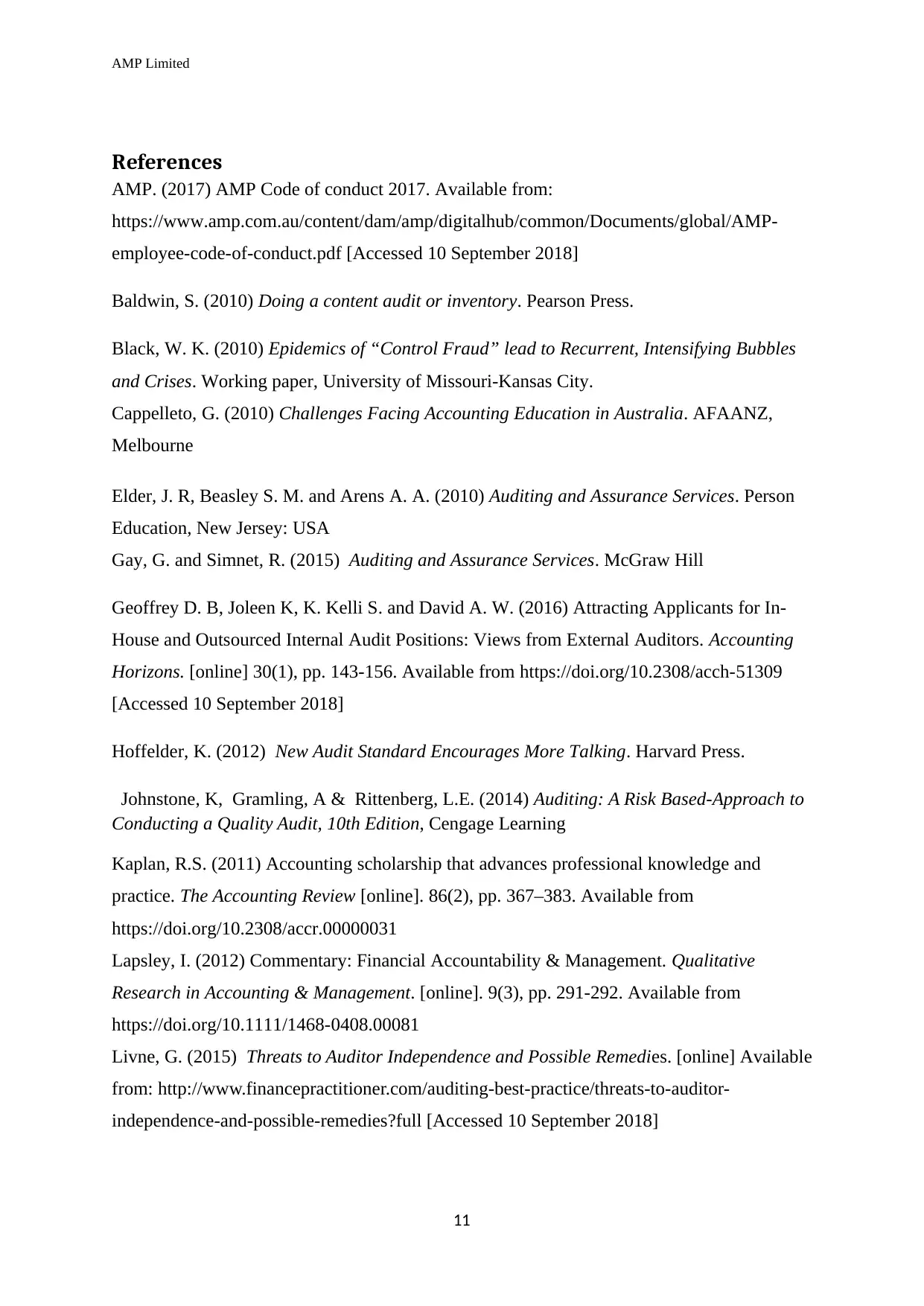
AMP Limited
References
AMP. (2017) AMP Code of conduct 2017. Available from:
https://www.amp.com.au/content/dam/amp/digitalhub/common/Documents/global/AMP-
employee-code-of-conduct.pdf [Accessed 10 September 2018]
Baldwin, S. (2010) Doing a content audit or inventory. Pearson Press.
Black, W. K. (2010) Epidemics of “Control Fraud” lead to Recurrent, Intensifying Bubbles
and Crises. Working paper, University of Missouri-Kansas City.
Cappelleto, G. (2010) Challenges Facing Accounting Education in Australia. AFAANZ,
Melbourne
Elder, J. R, Beasley S. M. and Arens A. A. (2010) Auditing and Assurance Services. Person
Education, New Jersey: USA
Gay, G. and Simnet, R. (2015) Auditing and Assurance Services. McGraw Hill
Geoffrey D. B, Joleen K, K. Kelli S. and David A. W. (2016) Attracting Applicants for In-
House and Outsourced Internal Audit Positions: Views from External Auditors. Accounting
Horizons. [online] 30(1), pp. 143-156. Available from https://doi.org/10.2308/acch-51309
[Accessed 10 September 2018]
Hoffelder, K. (2012) New Audit Standard Encourages More Talking. Harvard Press.
Johnstone, K, Gramling, A & Rittenberg, L.E. (2014) Auditing: A Risk Based-Approach to
Conducting a Quality Audit, 10th Edition, Cengage Learning
Kaplan, R.S. (2011) Accounting scholarship that advances professional knowledge and
practice. The Accounting Review [online]. 86(2), pp. 367–383. Available from
https://doi.org/10.2308/accr.00000031
Lapsley, I. (2012) Commentary: Financial Accountability & Management. Qualitative
Research in Accounting & Management. [online]. 9(3), pp. 291-292. Available from
https://doi.org/10.1111/1468-0408.00081
Livne, G. (2015) Threats to Auditor Independence and Possible Remedies. [online] Available
from: http://www.financepractitioner.com/auditing-best-practice/threats-to-auditor-
independence-and-possible-remedies?full [Accessed 10 September 2018]
11
References
AMP. (2017) AMP Code of conduct 2017. Available from:
https://www.amp.com.au/content/dam/amp/digitalhub/common/Documents/global/AMP-
employee-code-of-conduct.pdf [Accessed 10 September 2018]
Baldwin, S. (2010) Doing a content audit or inventory. Pearson Press.
Black, W. K. (2010) Epidemics of “Control Fraud” lead to Recurrent, Intensifying Bubbles
and Crises. Working paper, University of Missouri-Kansas City.
Cappelleto, G. (2010) Challenges Facing Accounting Education in Australia. AFAANZ,
Melbourne
Elder, J. R, Beasley S. M. and Arens A. A. (2010) Auditing and Assurance Services. Person
Education, New Jersey: USA
Gay, G. and Simnet, R. (2015) Auditing and Assurance Services. McGraw Hill
Geoffrey D. B, Joleen K, K. Kelli S. and David A. W. (2016) Attracting Applicants for In-
House and Outsourced Internal Audit Positions: Views from External Auditors. Accounting
Horizons. [online] 30(1), pp. 143-156. Available from https://doi.org/10.2308/acch-51309
[Accessed 10 September 2018]
Hoffelder, K. (2012) New Audit Standard Encourages More Talking. Harvard Press.
Johnstone, K, Gramling, A & Rittenberg, L.E. (2014) Auditing: A Risk Based-Approach to
Conducting a Quality Audit, 10th Edition, Cengage Learning
Kaplan, R.S. (2011) Accounting scholarship that advances professional knowledge and
practice. The Accounting Review [online]. 86(2), pp. 367–383. Available from
https://doi.org/10.2308/accr.00000031
Lapsley, I. (2012) Commentary: Financial Accountability & Management. Qualitative
Research in Accounting & Management. [online]. 9(3), pp. 291-292. Available from
https://doi.org/10.1111/1468-0408.00081
Livne, G. (2015) Threats to Auditor Independence and Possible Remedies. [online] Available
from: http://www.financepractitioner.com/auditing-best-practice/threats-to-auditor-
independence-and-possible-remedies?full [Accessed 10 September 2018]
11

AMP Limited
Manoharan, T.N. (2011) Financial Statement Fraud and Corporate Governance. The
George Washington University.
Matthew, S. E. (2015) Does Internal Audit Function Quality Deter Management
Misconduct?. The Accounting Review. [online]. 90(2), pp. 495-527. Available from
https://doi.org/10.2308/accr-50871 [Accessed 10 September 2018]
Merchant, K. A. (2012) Making Management Accounting Research More Useful. Pacific
Accounting Review. [online]. 24(3), pp. 1-34. Available from
https://doi.org/10.1108/01140581211283904 [Accessed 10 September 2018]
Reding, H.R, Sobel, P.J, Anderson, U.L, Head,M.J, Ramamoorti, S, Salamasick,M &
Riddle, C. (2015) Internal Auditing: Assurance & Advisory Services. 3rd Edition, The
Institute of Internal Auditor Research Foundation
Roach, L. (2010) Auditor Liability: Liability Limitation Agreements. Pearson.
12
Manoharan, T.N. (2011) Financial Statement Fraud and Corporate Governance. The
George Washington University.
Matthew, S. E. (2015) Does Internal Audit Function Quality Deter Management
Misconduct?. The Accounting Review. [online]. 90(2), pp. 495-527. Available from
https://doi.org/10.2308/accr-50871 [Accessed 10 September 2018]
Merchant, K. A. (2012) Making Management Accounting Research More Useful. Pacific
Accounting Review. [online]. 24(3), pp. 1-34. Available from
https://doi.org/10.1108/01140581211283904 [Accessed 10 September 2018]
Reding, H.R, Sobel, P.J, Anderson, U.L, Head,M.J, Ramamoorti, S, Salamasick,M &
Riddle, C. (2015) Internal Auditing: Assurance & Advisory Services. 3rd Edition, The
Institute of Internal Auditor Research Foundation
Roach, L. (2010) Auditor Liability: Liability Limitation Agreements. Pearson.
12
⊘ This is a preview!⊘
Do you want full access?
Subscribe today to unlock all pages.

Trusted by 1+ million students worldwide
1 out of 12
Related Documents
Your All-in-One AI-Powered Toolkit for Academic Success.
+13062052269
info@desklib.com
Available 24*7 on WhatsApp / Email
![[object Object]](/_next/static/media/star-bottom.7253800d.svg)
Unlock your academic potential
Copyright © 2020–2025 A2Z Services. All Rights Reserved. Developed and managed by ZUCOL.





